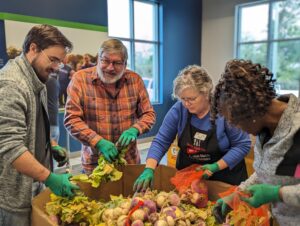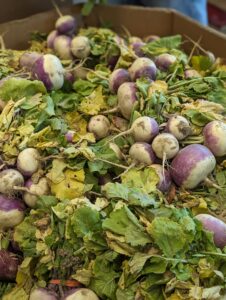Food Bank Tour and Lots of Turnips
go.ncsu.edu/readext?982060
en Español / em Português
El inglés es el idioma de control de esta página. En la medida en que haya algún conflicto entre la traducción al inglés y la traducción, el inglés prevalece.
Al hacer clic en el enlace de traducción se activa un servicio de traducción gratuito para convertir la página al español. Al igual que con cualquier traducción por Internet, la conversión no es sensible al contexto y puede que no traduzca el texto en su significado original. NC State Extension no garantiza la exactitud del texto traducido. Por favor, tenga en cuenta que algunas aplicaciones y/o servicios pueden no funcionar como se espera cuando se traducen.
Português
Inglês é o idioma de controle desta página. Na medida que haja algum conflito entre o texto original em Inglês e a tradução, o Inglês prevalece.
Ao clicar no link de tradução, um serviço gratuito de tradução será ativado para converter a página para o Português. Como em qualquer tradução pela internet, a conversão não é sensivel ao contexto e pode não ocorrer a tradução para o significado orginal. O serviço de Extensão da Carolina do Norte (NC State Extension) não garante a exatidão do texto traduzido. Por favor, observe que algumas funções ou serviços podem não funcionar como esperado após a tradução.
English
English is the controlling language of this page. To the extent there is any conflict between the English text and the translation, English controls.
Clicking on the translation link activates a free translation service to convert the page to Spanish. As with any Internet translation, the conversion is not context-sensitive and may not translate the text to its original meaning. NC State Extension does not guarantee the accuracy of the translated text. Please note that some applications and/or services may not function as expected when translated.
Collapse ▲Our Extension Master Food Volunteers recently toured the Food Bank of Central and Eastern North Carolina.

In front Paul Reinmann (Wilmington)
(left to right) Terry Amrhein (Sunset Beach), Margarete O’Leary (Supply), Avery Ashley, Family and Consumer Science Extension Agent, Laura Vaughan (Leland) , Jane Kulesza (Oak Island), Lori Van Horn (Ocean Isle Beach) and Cheryle Jones Syracuse, Extension Family and Consumer Science Team Member.
This food bank is located in Wilmington and services the five counties here in southeast NC—Brunswick, New Hanover, Pender, Columbus and Duplin. They estimate they distribute one million pounds of food each month.
The Food Bank is the largest hunger relief organization in the region. They serve as a hub for food distribution—and 22 food pantries and partner agencies from Brunswick County receive food from this food bank. They are also a place where individuals and organizations can drop off donations. There are also nutrition and education classes.
This is a new location for the food bank. There has been a food bank on Wilmington’s south side for over 40 years. We toured the old location back in 2022. They moved into this new location on Greenfield Street in April of 2023.
Greg Casaletto, Operations Manager gave us a tour of the large warehouse space of this impressive new facility. The new building has over 32,000 square feet of space. What’s really new is the large refrigeration and freezer space. Now they are able to receive and distribute fresh foods that they couldn’t do before. There is even space for a large community garden and they hope to start planting this spring.
Also included in the new building is a large commercial kitchen. One of the major goals of this kitchen is to be able to provide large numbers of meals to the community at times of need such as a hurricane or other disaster. The kitchen, under the leadership of Chef Kenneth Pohlman, is able to provide 5000 meals a day, if needed.
There is also a training center and place for nutrition, cooking and workforce
development education. We observed and instructor from Cape Fear Community
College teaching food service, food safety and food preparation for a group of students in the work force development program,
The Food Bank in Wilmington relies on the work of volunteers. Food Bank volunteers work alongside their staff in sorting and packing food and food boxes. The Food Bank estimates that the number of hours donated each year increases their workforce by 40%. One hour of volunteerism at the Food Bank provides the equivalent of 130 meals. If you’re interested in volunteering, check the food bank website for details and for shifts available.
While we were there, we were helped pack several large bins of turnips that had

Avery Ashley (Family and Consumer Science Extension Agent), Paul Reinmann (Extension Master Food Volunteer), Margarete O’Leary (Extension Master Food Volunteer) and Laura Vaughan (Extension Master Food Volunteer)
been donated by a farm near Faison, NC. Our project was to remove the wilted greens and pack the turnips into bags to ease distribution. We estimated the work of our team of eight volunteers helped the Food Bank provide 1040 meals.
We did wonder how these turnips would be used by those receiving them at a food
pantry. Kathleen Hoolihan, Nutrition Program Coordinator at the Food Bank shared
some recipes that they pass out with the produce to help folks make the best use of them…especially if they are unfamiliar with turnips.
Turnips can be eaten both raw and cooked. They are similar to and can be prepared like potatoes—boiled, roasted or fried. These recipes give turnips a different flare.
Parmesan Crusted Turnips
- 6 medium turnips, peeled
- 2 tablespoons, oil
- 3 cloves garlic, minced
- 1⁄2 cup parmesan cheese, grated
- Salt & pepper to taste
Fill large pot with water, add turnips and boil for 20-30 minutes, or until you can cut
through. Once soft, place turnips on paper towel. Press down on each so that each is flat. Drain for 15 minutes and let dry. Preheat oven to 375°F. In small bowl, mix garlic, oil, salt, and pepper. Cover baking sheet with aluminum foil or spray with cooking spray. Place turnips on baking sheet. Brush garlic oil mix on each turnip. Sprinkle cheese on top. Repeat on other side of turnip. Bake for 20-25 minutes, flip turnips. Cook for 15 more minutes. Serve them hot. Makes 8 servings.
Turnip Apple Slaw
- 1 turnip, peeled/thinly sliced
- 1 apple, thinly sliced
- 1 cup cabbage, shredded
- 1 medium carrot, grated
- 1 tablespoon thyme or parsley
- ¼ cup vinegar
Dressing
- 1⁄4 teaspoon salt
- 1 tablespoon honey
- 1⁄4 cup vinegar
- 1⁄2 cup oil
- 2 teaspoons mustard
In large bowl add turnips, apples, cabbage, carrot, spices, and 1⁄4 cup vinegar. Mix well. In small bowl, mix all dressing ingredients together. Pour over slaw. Serve cold. Use with tacos, burgers, chicken, side salad or fish.
Syracuse is a Family and Consumer Science team member and can be reached at N.C. Cooperative Extension, Brunswick County Center 910-253-2610 or by email at
clsyracu@ncsu.edu




